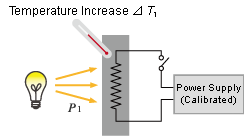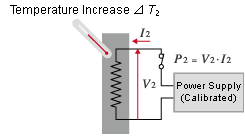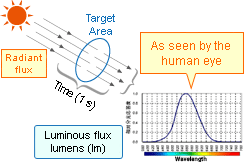Theory of Light and Color

4. Radiant Quantities and Luminous Quantities (Part 1)
The Energy of Light and Brightness Felt by the Human Eye
In Chapter 1 and Chapter 3, we specifically talked about brightness perceived by the human eye and machine vision with respect to wavelength. Brightness can be defined as the degree of stimulation that light (electromagnetic energy) exerts on sensors (the human eye and machine eye). The degree of stimulation is determined by the intensity of the stimulus on the emitting side and the sensitivity of the receiving side. Therefore, the next step in the discussion of brightness is how to measure and evaluate the electromagnetic energy of light and the amount of stimulation to the sensor.
Radiant Quantities and Luminous Quantities
On the emitting side are radiant quantities, the energy of electromagnetic radiation measured in watts (W), the same unit as electric power. ≪1≫
On the receiving side, there is the brightness felt by the human eye, known as luminous quantities and measured in lumens (lm).
In addition, there are various radiant quantities and luminous quantities according to different geometric conditions such as area and solid angle. Specifically, the radiant quantities are divided into
・radiant flux
・radiant energy
・irradiance
・radiant exitance
・radiant intensity
・radiance
Similarly, luminous quantities are divided into
・luminous flux
・quantity of light
・Illuminance
・luminous exitance
・luminous intensity
・luminance
Radiant Flux (Radiant Quantities) and Luminous Flux (Luminous Quantities): Common Geometric Conditions
Radiant flux and luminous flux can help illustrate the similarities and differences between radiant quantities and luminous quantities. Consider a showerhead, which sprays an infinite number of water droplets. The showerhead corresponds to the radiant source (light source), and the momentum of the flow of water droplets corresponds to the radiant flux (luminous flux). ≪2≫
By increasing the water flow, the momentum of the water droplets becomes stronger (the amount of water ejected per unit time), similar to the luminous flux (radiant flux).

Differences Between Radiant Flux and Luminous Flux
Light propagates as electromagnetic energy through a medium such as air or glass, and radiant flux is the amount of radiant energy transmitted through a targeted area per unit time (e.g. 1 sec). Energy is measured in joules (J), and the unit of measure for radiant flux is the watt (W), defined as the energy emitted per unit time (joules per second (J / s)).
On the other hand, luminous flux measures the perceived intensity of radiant flux according to the sensitivity of the human eye. ≪3≫ The unit of measure is the lumen (lm). ≪4≫
The luminous flux expressed in lumens is the basis of photometric quantities, and the measure of illuminance and luminance is also based on the lumen.

Summary
This chapter discussed the radiant quantities and luminous quantities, in particular radiant flux and luminous flux, where luminous flux is the intensity of radiant flux to the human eye. Next, we will explain the measure of radiant flux to the machine eye.
Comment
≪1≫ Radiant flux unit watt (W) and electric power unit watt (W)
The unit of measure for power is the watt (W), which is the product of current, measured in amperes (A), and voltage, measured in volts (V). Both radiant flux and electric power are measured in watts although they are not the same.
A watt is the amount of work per unit time, defined as joules per second (J / s), but in fact, the heat generated is also work.

If a blackbody electric resistor were irradiated with an amount of radiant flux, all the energy of the radiant flux would be absorbed by the resistor and converted into heat, causing a rise in temperature.
Suppose that irradiating with radiant flux P1 (W) for t1 (s) raises the temperature of the resistor by ΔT1, and that applying the electric power P2 (W) (voltage V2 (V), current I2 (A)) for t2 (s) generates heat through electric energy and raises the temperature of the resistor by ΔT2.

The electrical energy (electrical work) is
P2 ・ t2 = V2 ・ I2 ・ t2 [ W・s ] = V2 ・ I2 ・ t2 ( J )
If you adjust V2, I2, and t2 to obtain ΔT1 = ΔT2, then the radiant flux does the same amount of work as the applied power. That is,
P1 ・ t1 = P2 ・ t2 = V2 ・ I2 ・t2 = ( J )
The right side of the equation can be found with a voltmeter and an ammeter. Thus, as shown in the equation below, the radiant flux can be expressed as watts like electric power.
P1 =( t2/ t1 )・ V2 ・ I2
≪2≫ Image of photons
In this analogy, each water droplet corresponds to a photon. Therefore, the innumerable water droplets (photons) make up the water flow (light).
≪3≫ To see with the human eye

To perceive the radiant flux with the human eye means to evaluate it with the spectral response characteristics of the human eye, that is, the standard spectral luminous efficiency defined by V (λ). When weighted by V (λ), the brightness perceived by the human eye is the luminous flux. In other words, the radiant flux (one of the radiant quantities) and the luminous flux (one of the luminous quantities) share common geometrical conditions but different spectroscopic conditions. The spectroscopic condition for radiant flux evaluates the physical energy itself, but in the case of luminous flux, it is weighted by the standard spectral visual efficiency V (λ).
≪4≫ The unit of luminous flux lm
Luminous flux measures the brightness of light as perceived by the human eye.
To convert radiant quantities (W) to luminous quantities (lm), you must multiply by a constant known as maximum luminous efficacy, denoted as Km = 683 (lm / W).
If the radiant flux with a spectral distribution P (λ) (W / nm) is φe (W), and the corresponding luminous flux is φv (lm), φe and φv can be expressed mathematically as follows,
(The subscript e is an acronym for energy and the v is for vision.)

The standard spectral luminous efficiency V (λ) has a peak at a wavelength of 555 nm. With this as 1, the luminous efficiency at other wavelengths is relatively defined. For example, when the radiant flux of monochromatic light with a wavelength of 555 nm has 1 watt (W) of energy, the luminous flux is 683 lumens (lm).
Radiant Quantities and Luminous Quantities (Part 1)
The Energy of Light and Brightness Felt by the Human Eye

